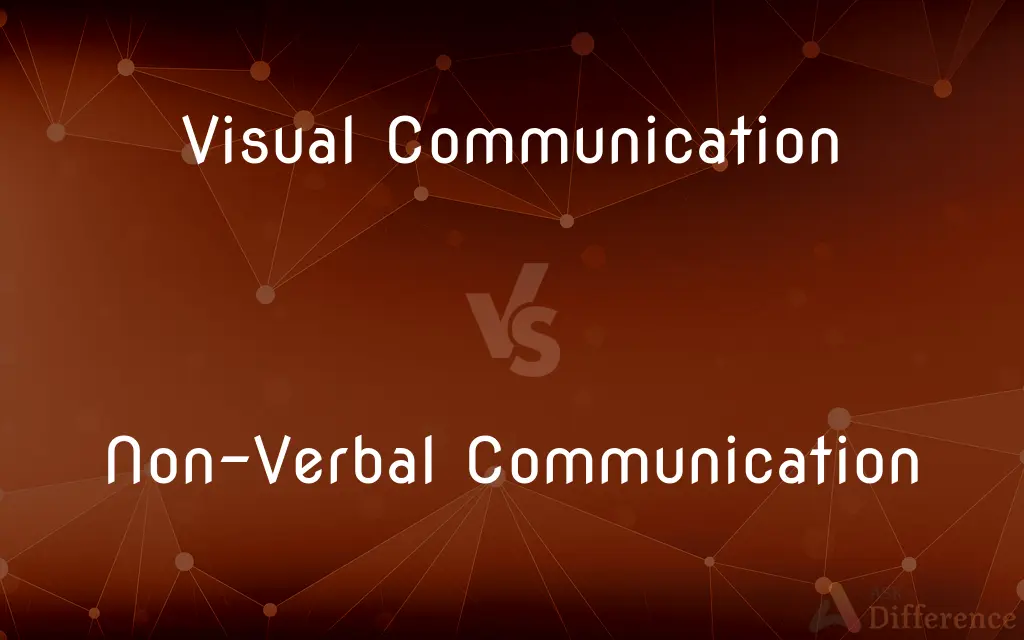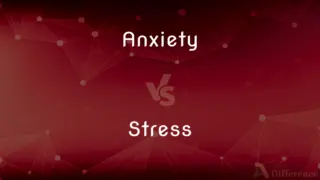Visual Communication vs. Non-Verbal Communication — What's the Difference?
By Tayyaba Rehman — Published on October 1, 2023
Visual Communication uses visual elements like images and graphics to convey messages; Non-Verbal Communication involves body language, facial expressions, and gestures.

Difference Between Visual Communication and Non-Verbal Communication
Table of Contents
ADVERTISEMENT
Key Differences
Visual Communication is a method that relies on the use of visual aids such as graphics, images, and illustrations to convey information and messages to an audience. Whether it's infographics, diagrams, or photographs, Visual Communication is primarily about transmitting ideas through visual representation. On the other hand, Non-Verbal Communication pertains to the transmission of messages without the use of spoken or written words, often relying on body language, facial expressions, and gestures.
Non-Verbal Communication encompasses a broad range of actions, such as nodding in agreement, raising eyebrows in surprise, or maintaining eye contact during a conversation. While Visual Communication is based on designed visual content to share information, Non-Verbal Communication is inherent in our daily interactions and spontaneous reactions.
In the world of advertising and media, Visual Communication plays a pivotal role, crafting messages through engaging visuals to capture audience attention. In contrast, Non-Verbal Communication is critical in personal interactions, aiding in understanding intent, emotions, or underlying thoughts without vocal articulation.
Both Visual Communication and Non-Verbal Communication are essential forms of conveying messages without relying heavily on spoken language. However, while Visual Communication focuses on designed, purposeful visual aids, Non-Verbal Communication centers on organic, often subconscious, bodily cues and expressions.
Comparison Chart
Primary Elements
Graphics, images, illustrations
Body language, gestures, facial expressions
ADVERTISEMENT
Use Case
Advertising, media, education
Daily interactions, conveying emotions, personal relations
Intentionality
Often designed and planned
Can be spontaneous and subconscious
Role in Communication
Conveying complex data or information visually
Enhancing or clarifying spoken communication
Dependency on Spoken Language
Minimal (relies more on visuals)
Minimal (relies more on physical cues)
Compare with Definitions
Visual Communication
Expressing data or concepts with visual tools.
Infographics are a popular form of Visual Communication to simplify complex data.
Non-Verbal Communication
Communication using body language or gestures.
He nodded, a universal Non-Verbal Communication of agreement.
Visual Communication
Sharing ideas using visual elements.
The poster's Visual Communication effectively spread awareness about the event.
Non-Verbal Communication
Relaying messages without speaking or writing.
The intensity of their eye contact was a potent form of Non-Verbal Communication.
Visual Communication
The conveyance of information using visual aids.
The company used Visual Communication techniques in their presentation to engage their audience.
Non-Verbal Communication
Transmitting information via physical cues.
Her posture, a form of Non-Verbal Communication, conveyed confidence.
Visual Communication
Relaying messages through graphics or imagery.
With the rise of social media, Visual Communication has become more prevalent in marketing.
Non-Verbal Communication
Interacting without vocal or written expression.
Their hug was a heartfelt Non-Verbal Communication of comfort and support.
Visual Communication
Communicating through designed visual content.
Brands prioritize Visual Communication to connect with their target audience.
Non-Verbal Communication
Expressing thoughts or feelings without words.
Her frown was a clear form of Non-Verbal Communication, indicating her disapproval.
Common Curiosities
What are the main elements of Visual Communication?
The main elements of Visual Communication include graphics, images, and illustrations.
Is an emoji a form of Visual Communication?
Yes, emojis visually convey emotions or ideas, making them a form of Visual Communication.
How does Non-Verbal Communication differ from silent communication?
While both avoid words, Non-Verbal Communication uses gestures, facial expressions, and body language, while silent communication may use written messages or signs.
Can Visual Communication stand alone without any verbal support?
Yes, Visual Communication can effectively convey messages independently, especially when well-designed.
How important is Non-Verbal Communication in daily interactions?
Extremely important; Non-Verbal Communication can convey emotions, clarify messages, and enhance verbal communication.
Does Visual Communication require professional design skills?
While professional skills enhance quality, anyone can use basic Visual Communication tools or platforms.
Is sign language considered Non-Verbal Communication?
Yes, sign language is a form of Non-Verbal Communication as it communicates without vocal speech.
Are graphs and charts considered Visual Communication?
Yes, graphs and charts visually represent data, classifying them under Visual Communication.
How can one improve their Non-Verbal Communication skills?
By observing others, being conscious of one's body language, and seeking feedback on personal interactions.
How can one decode Non-Verbal Communication?
By observing context, cultural cues, and being attentive to inconsistencies between verbal and Non-Verbal Communication.
Share Your Discovery

Previous Comparison
Brother vs. Intimate
Next Comparison
Anxiety vs. StressAuthor Spotlight
Written by
Tayyaba RehmanTayyaba Rehman is a distinguished writer, currently serving as a primary contributor to askdifference.com. As a researcher in semantics and etymology, Tayyaba's passion for the complexity of languages and their distinctions has found a perfect home on the platform. Tayyaba delves into the intricacies of language, distinguishing between commonly confused words and phrases, thereby providing clarity for readers worldwide.
















































